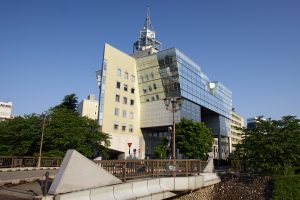
Toyama City Hall
Toyama City is creating a smart city system to streamline and enhance urban functions and services by collecting, analysing, and utilising various data and making full use of the sensor network that covers the entire city, to provide new services, improve the efficiency of administrative affairs, and foster new industries through the IoT (Internet of Things).
The “Toyama City Sensor Network” consists of an LPWA (Low Power Wide Area Wireless Technology) network that aggregates information from various sensors and a platform that manages data collected from IoT sensors. The LPWA network was developed in 2018, and antennas were installed in about 100 public facilities in the city. It covers 98.9% of the resident population.
The city carried out a monitoring project for elementary school students in FY2018 as a pilot trial utilising the sensor network. A GPS (Global Positioning System) sensor lent to the children was used to investigate the route to and from school, which was mapped with the placement of traffic safety volunteers. The smart city is expected to improve citizen services such as school safety, revitalise business activities, and create new value for Society 5.0.
After the pilot project, the city embarked on further utilisation of the sensor network. In FY2019, Toyama started a demonstration experiment that allows private businesses to utilise the sensor network free of charge. There were applications from a wide range of fields such as transportation/people flow, agriculture, remote monitoring/disaster prevention, welfare/nursing care, performance evaluation/facility management, and 23 case studies (36 groups) were adopted.
In one of them, the electrical engineering company Nippon Koei installed a monitoring system that detects abnormalities in bridges. Sensors were placed on a bridge in a mountainous area about 20 km away from the city centre; if an abnormality such as an opening or a break occurs in the structure, indicator lights installed on-site will blink to warn users. Nippon Koei also built a mechanism to notify the administrator via the sensor network. It was demonstrated that it would lead to labour saving in confirming work needed on bridges, otherwise difficult for city officials to patrol and inspect daily.
Furthermore, to promote matching between the public and private sectors, develop new services, and revitalise local industries, a demonstration experiment result report meeting was held in March, and the details of each initiative were publicly discussed. Toyama continued to expand the scope of demonstration experiments in FY2020, and according to the Information and Statistics Division of the City Planning and Management Department, 11 demonstration projects will continue from FY2019, and the City has received several new applications. Final reporting back is also planned at the end of the fiscal year.
The city is also considering cooperation between existing platforms already in operation and the sensor network. One of the targets is the “Toyama City Lifeline Common Platform” built through public-private collaboration. Various information related to roads, electricity, gas, communications, and traffic is collected and used for disseminating local area information related to ensuring safety in daily life and work, giving a complete picture of the situation in the event of a disaster, meaning disseminating information in an emergency can be done swiftly where the difference of a few minutes could potentially save lives. For example, one of the information systems, “Life Map Toyama,” displays parts of the city currently under construction as well as viewing construction information such as the contractor and period of construction.
Toyama City is also exploring information collaboration with the “Toyama City Open Data Site,” publishing various administrative information as open data, improving citizen services, stimulating business activities, working towards Society 5.0 and the convergence of cyberspace and physical space which creates extra value for local citizens.
Picture by 663highland – Own work, CC BY 2.5, https://commons.wikimedia.org/w/index.php?curid=5269661

